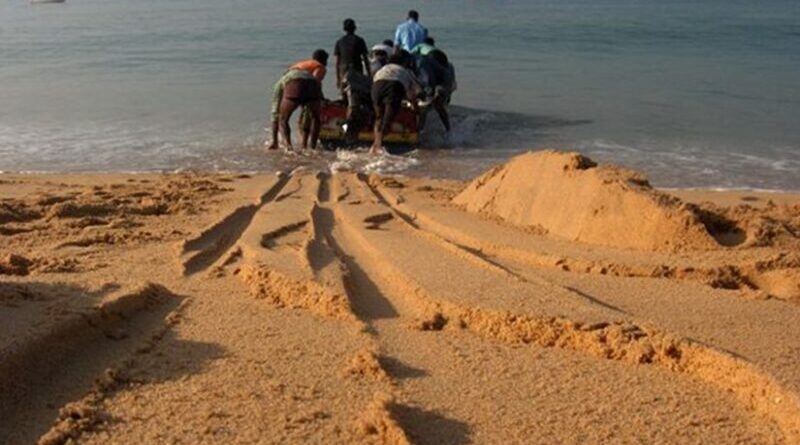The Island And The Mainland: Impact Of Fisheries On Indo-Lanka Relations – Analysis
By IPCS
By Asanga Abeyagoonasekera*
At the southern tip of India, in a narrow stretch of water where the seascape begins, is one of the region’s geopolitical hot spots.
The waters between India and Sri Lanka are rich in history and mythology. According to Valmiki’s Ramayana, there is only one point of connection between the two nations: the man-made bridge that Rama and Hanuman used to reach Sri Lanka and rescue Rama’s wife Sita from the demon King Ravana of Lanka. This bridge was renamed the Adams Bridge by British cartographers at the beginning of the 20th century. The geographical stretch of water here, called the Palk Strait, has served as a rich fishing ground for fishermen.
The thirty-year war that devastated Sri Lanka has had many implications for the state of Tamil Nadu in southern India. Often, Indian central government policy highly influences popular Tamil Nadu party politics and vice versa, which has threatened Indo-Sri Lanka relations on many occasions. Post war Indo-Sri Lanka relations have been challenging and have sometimes threatened the sovereignty of Sri Lanka. For example, the recent announcements by Tamil Nadu Chief Minister Jayalalitha on claiming Katchatheevu island and establishing a separate state, “Eelam”.
Despite this, the most pressing issue remains state sovereignty and the fishermen dispute. Chief Minister Jayalalithaa plays a pivotal role as a sympathiser of Tamil Nadu fishermen who encroach Sri Lankan fishing grounds, and also as a protector of the fisheries’ business owners who own and operate mechanised industrial bottom trawlers. Indian fisherman ripped out the rich seabed using the bottom trawlers; a practice now banned globally. There is also evidence of a few Sri Lankan fishing boats being converted with this method; the justification being, if India can do it in Sri Lankan waters, why can’t Sri Lankans themselves? The authorities should take strict measures to confiscate these trawlers as they destroy the rich biodiversity of the ocean.
The fishermen claim they are ignorant about the existence of the International Maritime Boundary Line (IMBL). There are reports that more than 3,000 Indian fishing boats engage in illegal, unregulated and unreported (IUU) fishing in Sri Lankan waters. Both governments had met many times to resolve this dispute with arrests of fishermen from both sides. During Sri Lankan President Sirisena recent visit to India, Prime Minister Modi stated the need to find a permanent solution to the issue of fishermen straying into each other waters. As a solution, the issuing of licenses to a few Indian fishing trawlers with limited catch – to minimise mass scale fisheries and resource depletion – is on the anvil. A technical proposal will be drawn up and submitted to the Indian Government, according to Sri Lanka’s Secretary of Defence. This method is not new – in 1976, the maritime boundary agreement between the two countries was to issue up to six permits to Sri Lankan vessels with 2,000 tons per year for three years at Wadge Bank, south of Kanyakumari. A recent newspaper reports the Sri Lankan Fisheries’ Minister as having said, “At present 2,000 to 3,000 Indian trawlers fish in our waters. The aim is to reduce it to 250 and to issue license to them.”
If these licenses are issued to the Indian mechanised bottom trawlers, there will be objections from Sri Lankan fishermen. If it is for ordinary fishing vessels, templates such as New Zealand’s Quota Management System (QMS) could be looked at. In the past, when fisheries’ resources in New Zealand were depleting, the authorities set up a QMS to allocate fishing vessels to demarcated zones inside the Exculsive Economic Zone (EEZ), with an annual quota that could be traded at an electronic trading market. If a fisherman had stocks left, he could trade with another. Sri Lankan fisheries officials studied this system in 2008.
The Sri Lankan fisheries association and its Indian counterpart could study a system like the QMS to resolve the issue, as the former has reservations about granting licenses to Indian trawlers to fish in Sri Lankan waters. A customised QMS and the creation of a joint fisheries association with a registered database of fishing vessels is an option. As it stands, the existing GPS device used by Indian fishermen, which indicates proximity to the IMBL with a beep, is of no use if the transponders are switched off to engage in illegal fishing. Any effort to resolve the issue will fail if certain standards are not followed and rule-breakers are not punished. In Malaysia, for example, if the transponders are switched off, the authorities automatically fine the fishermen.
There is still no legislation in Sri Lanka banning bottom trawling, and this should be taken up immediately to preserve the rich ocean ecology. The department of fisheries has currently stopped issuing licenses but this is not sufficient – introducing the right law is essential. In fact, this situation involving bottom trawlers has worsened this year in comparison to the last, with a serious increase in the number of boats. More than 50,000 Sri Lankan fishing families in the north have been affected and huge revenue losses are incurred everyday due to illegal fishing by Indian trawlers.
The Governments of India and Sri Lanka should come together to find a comprehensive and sustainable solution that takes into account both the challenging geographical space and the rich biodiversity in this area. If left alone in the present state, the issue could create a serious strain on the India-Sri Lanka relationship.
* Asanga Abeyagoonasekera
Former Executive Director, Lakshman Kadirgamar Institute of International Relations and Strategic Studies (LKIIRSS), Sri Lanka

